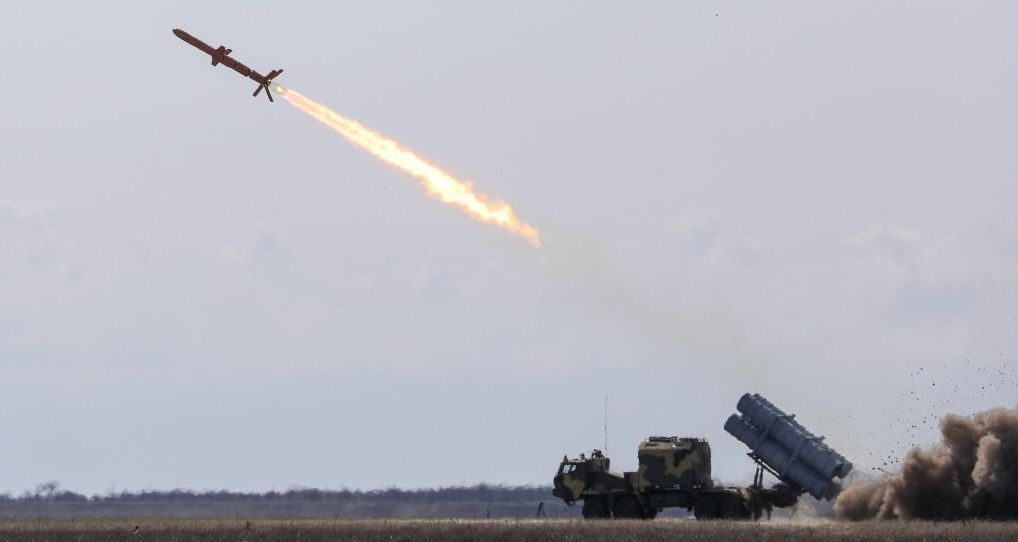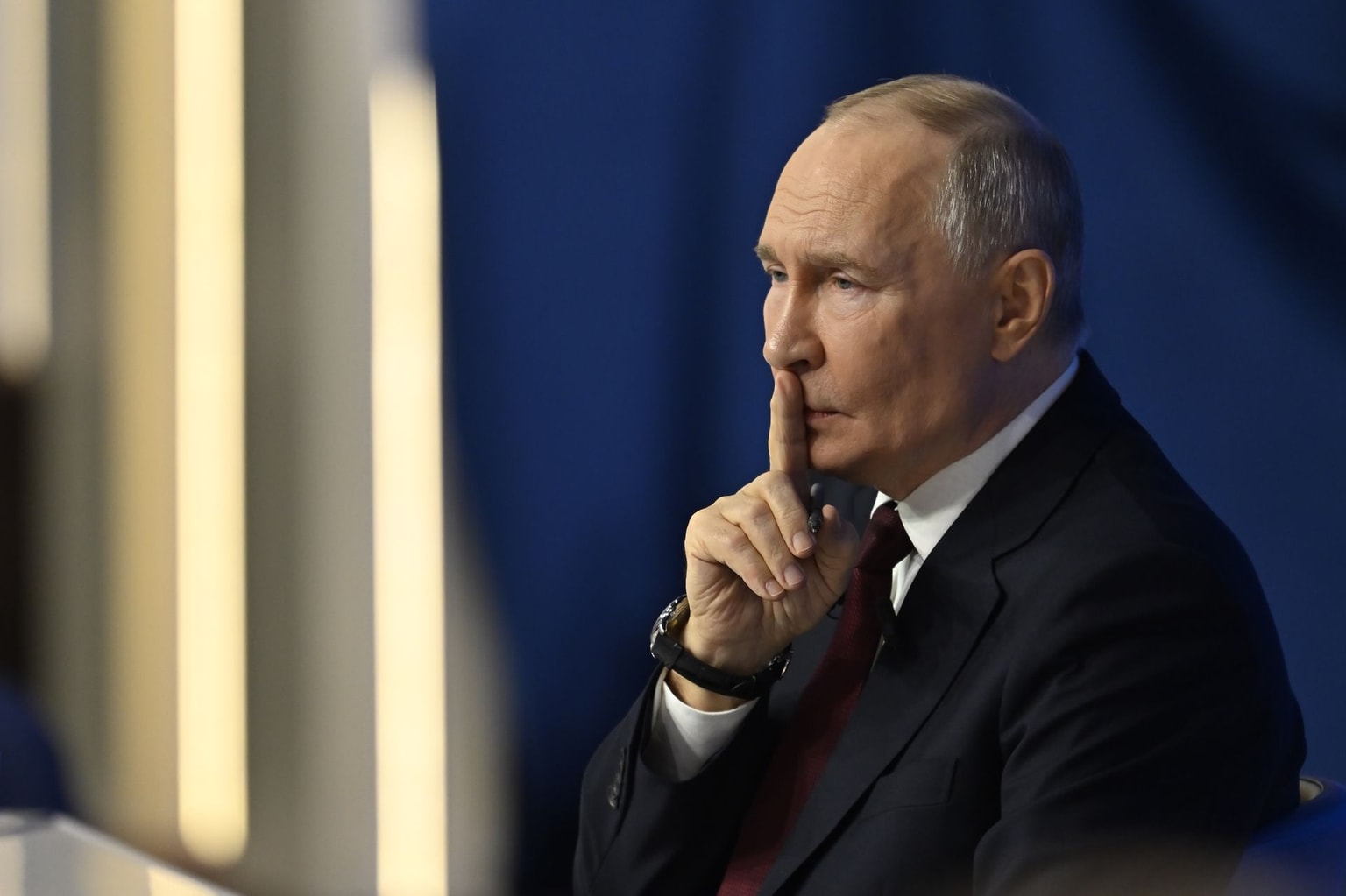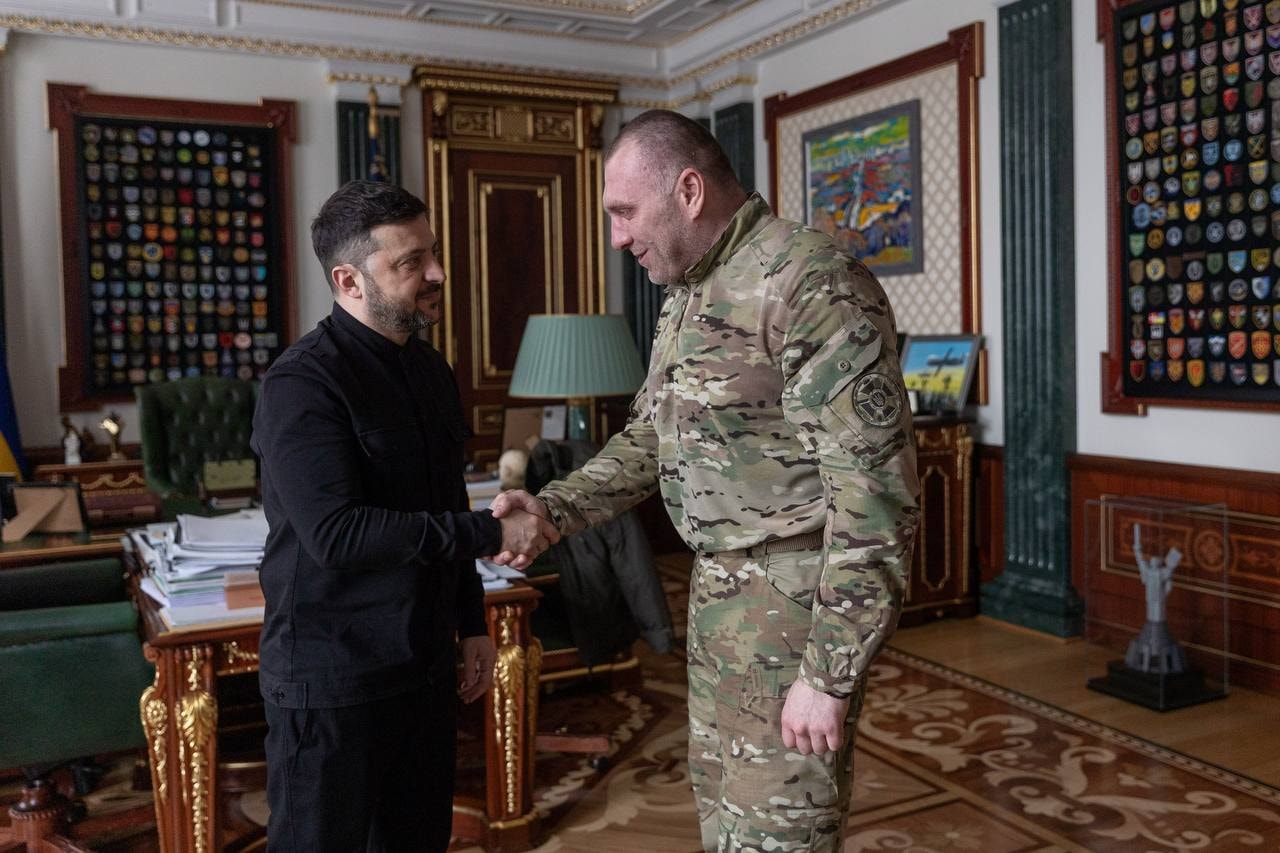
Ukraine’s long-suffering aerospace giants look to Europe to break free from Russian orbit
A display of Ukraine's new 'Peklo' (Hell) missile-drones in Kyiv on Dec. 6, 2024. (Viacheslav Ratynskyi/Anadolu via Getty Images)
Where the Donbas meets the Dnipro River, the USSR built out a dense range of massive factories, using the local coal and metal reserves to smelt, weld, and cast the heaviest of machinery — and weaponry — for the whole of the Soviet Union.
One of these is Pivdenmash, formerly known by the Russian name, Yuzhmash, a factory that is effectively a city unto itself in the south of the city of Dnipro in central-eastern Ukraine. The great builder of the Soviet intercontinental ballistic missile (ICBM) arsenal and space launchers, Pivdenmash, a short form of the Ukrainian for “Southern Machine-building Plant,” is today a shadow of its former self.
Even with the current demand for weaponry for Ukraine’s war effort, Pivdenmash is mired in decades of financial missteps. While central Dnipro has benefited from a youth and tourist revival, the “city within a city” is a vortex of Soviet concrete and steel-gray cobblestone, called brukivka, much of it crumbling or bestrewn with graffiti. Many of the component factories that make up the whole complex are offline. It’s a fate shared with much of the rest of Dnipro’s industrial outskirts, which closely resemble an eastern bloc Detroit.
While the U.S. is locked in some analogous wrestling with its own industrial legacy, Ukraine faces more acute challenges. Russia’s regular air strikes on the factory, for example, do nothing to help Pivdenmash’s plight. But even pre-war Pivdenmash spent decades lamenting that the Ukrainian government never contracted rockets while also barring the firm from selling off its residual rocket-making machines.
The full-scale war has boosted Ukraine’s production of rockets and ballistic missiles, but money is excruciatingly tight. Ukraine’s parliament intervened in February with legislation keeping Pivdenmash from declaring bankruptcy until Jan. 1, 2026. But that’s only a stopgap.
Pivdenmash is far from alone. Eastern Ukraine's industrial belt is a unique local resource that has struggled to find a role beyond oligarchic self-enrichment throughout the country’s independent history. When it comes to top-line ambitious projects like aerospace, Pivdenmash has struggled to keep the lights on independent of the Russian firms that descend from the same Soviet factory networks.
The greatest hope for Ukraine’s military-industrial complex is to survive wartime and link with the European Union. That wouldn’t only serve Ukraine’s long-term self-defense. The EU, which has spent the last 30 years assuming the protection of the U.S., also stands to gain more from these factories’ survival rather than let nigh-irreplaceable massive machining equipment rust out and generational expertise die off.
Dnipro rocket city
Much of Dnipro’s history is defined by the Soviet arms race with the U.S. — an odd source of pride and nostalgia, grievance, and regret. As a defense hub, the city was barred to foreigners and, for a spell, wiped from maps published in English. To date, a trio of Yuzhmash-stamped rockets sit in the center of the Dnipro town square, bristling skyward.
“All our rockets were pointed west in those days,” chuckles Oleksiy Kulyk, the head of the Makarov Aerospace Education Center in Dnipro, which is funded by former rocket makers to venerate the industry’s local history and try to get new generations into aerospace.
“Those missiles that we gave up in the 90s, in the disarmament treaty — which the U.S. took part in — are now coming back down on us.”
A veritable arsenal of decommissioned missiles sits in the parking lot behind the Makarov Center. A Russian strike, however, blew out the center’s back wall facing that lot in September.
Adding insult to injury in these attacks are the disarmaments Ukraine signed in the 1990s, surrendering rockets in exchange for security guarantees from the U.S. and Russia as part of the Budapest Memorandum.
“Those missiles that we gave up in the 90s, in the disarmament treaty — which the U.S. took part in — are now coming back down on us,” said Kulyk. “Ukrainian rockets to the present day stand in the Russian Federation’s arsenal. If you could get acquainted with those productions, the Oreshniks and those, I’m more than certain that you’d find many, many parts that were made during the Soviet Union here in Ukraine.”

It’s a legacy that is still a source of local pride.
“There were no computers in those days, and look at the jeweler’s precision of the details, the quality of the metal — it’s all quality,” a guide explained, showing off the metal ribs inside a locally made jet engine. “All of this was in our region. You can imagine the level the specialists studied at. Even the workers. What artful work the rank-and-file workers did!”
The aerospace education center takes its name from Oleksandr Makarov, who ran Pivdenmash for thirty years, through the mid-80s, nearly until the fall of the Berlin Wall.
Like most of the giants of Soviet weapons manufacturing, Pivdenmash began its life in World War II. After the Red Army drove the Third Reich from Dnipro, Stalin ordered the construction of a factory to make the vehicles that would take them on to Berlin.
In 1951, the massive factory turned from cars to rockets, the first being direct copies of German V2s.
During the height of the arms race with the U.S., Pivdenmash would become maybe the largest missile maker in the world, building Dnipro up along with it. The engineers at Pivdenne, the attached construction bureau, would design, and the factory workers of Pivdenmash would build the civilian Zenits and the R-36, the largest ICBM ever, known in the West as the “Satan.”
Anatoliy Sanin moved to Dnipro to teach aerospace materials engineering at the Oles Honchar University in 1980. The department he now heads was founded in 1952 specifically to feed talent to Pivdenmash, which had started making missiles just the year before.
Sanin got to see, he recalls, five good years before then-Soviet Premier Mikhail Gorbachev’s reductions in defense spending would take their toll on the local industry, right around the time that Makarov himself retired. The 90s were famously brutal within Ukraine, with Dnipro no exception. Professors got used to paychecks going missing. Students moved from hard engineering to IT, with its promise of earning Western money.
A reputation for corruption dogs Dnipro to this day. Makarov’s successor at Pivdenmash, Leonid Kuchma, would go on to become the inauspicious second president of Ukraine. Rocket manufacturing would resume in the 90s, but with continued uncomfortably tight bonds with Russia that would become a hallmark of Kuchma’s presidential legacy.
New orders for Zenit rockets barely sustained Pivdenmash’s aerospace manufacturing in the 90s. Those rockets, in turn, became the basis for SeaLaunch, a launch platform that, per its name, literally launches from a ship.
Those 90s projects remained thoroughly within the network of post-Soviet engine works, jet fuel plants, and launch sites that stretched from Kyiv to Kazakhstan. The Zenits specifically required Russian jet engine company Energomash to make the motors. Even prior to 2014, reports said Ukrainian workers were getting just three shifts a week, with one saying he was making less than 1/30th the salary of his Russian peers.
Kyiv severed those industrial ties after Russia’s 2014 invasion. But the industry within Ukraine was suddenly unmoored from the Russian firms they’d always built with — and the Russian money they’d depended on.
In 2015, Pivdenmash wrote the Ukrainian government an open letter lamenting that they’d had no state orders for missiles for over half a year. The letter even asked for authorization to sell off remaining missile-making machines.
Pivdenmash General Director Serhiy Voyt complained that the Ukrainian government took 70% of the missile maker’s profit and scared away foreign partnerships in a 2020 interview. He also said that prior to 2014, 70% of the firm’s space work was in “cooperation” with Russia.
The same messy divorce with Russian manufacturing killed Northrop Grumman’s Antares rockets, which blended Pivdenmash and Energomash construction with American technology. While the Antares demonstrate the difficulties of Ukrainian firms operating alone, it also showed that even the giants of U.S. aerospace want to use Pivdenmash’s manufacturing.
Pivdenmash’s representatives declined interview requests.
The Kyiv Independent has previously written about Ukraine’s struggle to build its own ballistic and cruise missiles. At a press conference on April 11, Strategic Industries Minister Herman Smetanin said that Ukraine had successfully brought production of ballistic missiles up by a factor of eight in 2024, saying that “we are deploying ballistic missiles every month.”
The ballistic programs are subject to intense security restrictions that make these figures impossible to verify independently. The Ukrainian government likewise refuses to confirm the builder of the ballistic “Hrim” program as Pivdenmash or anyone else. The head of the Russian space agency, Roskosmos, identified Pivdenmash as the source of Ukraine’s ballistic missiles at the start of the full-scale war, and they are the only game in town if Hrims are, in fact, built inside of Ukraine.

Regardless of the new wartime market and presumable government orders, firms like Pivdenmash, planemaker Antonov, or jet engine giant MotorSich remain deeply financially dysfunctional, requiring regular government bailouts and debt forgiveness. But they are at least building things again.
The fact that the Soviet expertise has not fully slipped away to age or brain drain is also critical, says Semenov. “The projects stretch out for years — to put together some kind of motor, or some kind of unit or some kind of aircraft, you need at least five to ten years. Not many people have that kind of endurance.”
“The fact of the matter is that only crazy people work in aviation,” Semenov said. “Thank God there are still people, there’s still knowledge, and new teams are being prepared.”
Sanin, for one, has been heartened by new engagement from his students, many of whom have taken to working on missiles or drones. “Over the past two years, our students have shown a new desire for self-actualization. Every month, the number of students who want to study and work at the same time is growing,” said Sanin. He notes an example of three days earlier, having a grad student present Pivdenmash with a dissertation on a new method of smelting aluminum, a go-to material for spacecraft from Sputnik’s body to SpaceX’s rocket cores.
There remain two primary pain points: Replacing components and financing that once came from Russia. For both, Ukraine is looking West, particularly to Europe.
Westward Rewiring
Ukrainian President Volodymyr Zelensky said in November that the country had produced its first 100 missiles complexes, though he was vague about exactly which. He was not vague about spotlighting Denmark and France for thanks.
The European connections are not new. Pivdenmash’s components have long stood in for manufacturing gaps in countries like Italy and Germany, largely because much of Europe never built its own supply chains.
The U.S. is, in the inverse, remarkably touchy about foreign entities entering its aerospace. The Russian Mikhail Korotich was pushed out of Silicon Valley, ending up in France and making deep-strike drones for Ukraine.
Dnipro-trained Maxim Polyakov met a similar fate when he bought a majority share in floundering Texas-based start-up Firefly Aerospace. Fearful of a leakage of U.S. rocket design information, the Committee on Foreign Investment in the United States in late 2021 forced Polyakov to divest from the firm he had rescued from bankruptcy.
“We are integrating more with the European market and with the American market.”
The Biden administration reversed that decision in 2024, per a press release from Noosphere, Polyakov’s more recent startup, which heavily funds projects in Dnipro. Yet Firefly Aerospace soundly denied any lingering connections to Ukraine in an email to the Kyiv Independent.
Europe is protective of local industry, but there’s less local industry to protect. Ukrainian aerospace has likewise retained some suspicion towards the West. Pivdenmash’s head, Voyt, told the press in 2020 that “all Europe wants is for us to send them our blueprints.”
Those barriers are changing based on wartime necessity.
“As we say, there would be no good luck if not for bad luck,” says Semenov. “We are integrating more with the European market and with the American market. Which will help us in the future, strengthening our connections with European producers.”
There is no question that Pivdenmash and its like are unique in what they can build, says Michael Duitsman, a fellow at the the Middlebury Institute's James Martin Center for Nonproliferation Studies.
“In terms of technology, they're still pretty close to state-of-the-art,” says Duitsman. Particularly, for major ICBM or space launch systems, Europe never had the kind of industry that the Soviet Union did. “Outside of France, there is not a lot of missile and rocket manufacturing of the sort that you need to build a space program in Europe.”
The urgency of pointing to the West is not lost on Semonov, who spoke to the Kyiv Independent from a balcony in Italy.
“By my estimation, there’s enough potential, people left alive, technology, and factories for Ukrainian aerospace to survive for the next 10-15 years,” said Semonov. “After that, it all depends on how Ukraine fits into the global order.”
Note from the author:
Hi, this is Kollen, the author of this article. Thanks for reading. Ukrainians’ responses to Russia’s invasion showcase a society that is deeply resilient and inventive, despite pullbacks in aid. If you like reading stories highlighting the development of Ukraine's wartime technology and economy from on the ground, please consider supporting our work by becoming a member of the Kyiv Independent.










